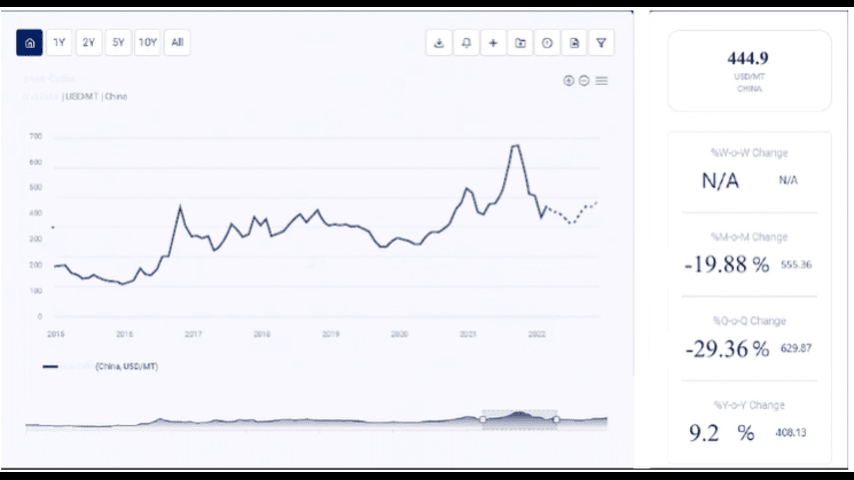Corn is a staple crop globally, used for food, animal feed, and as a raw material in various industrial processes, including biofuel production. The corn price trend analysis is influenced by multiple factors, including weather conditions, supply and demand dynamics, geopolitical events, and economic policies. Understanding corn price trends is essential for farmers, traders, policymakers, and consumers. This article provides an in-depth analysis of corn price trends, covering historical data, recent fluctuations, market dynamics, and future outlook.
Historical Price Trends
Early 2000s to 2010
From the early 2000s to 2010, corn prices experienced significant fluctuations. Key factors influencing prices during this period included:
- Weather Conditions: Adverse weather events such as droughts, floods, and storms in major corn-producing regions affected crop yields and prices.
- Global Demand: Rising global demand for corn, driven by population growth, increased livestock production, and the burgeoning biofuel industry, impacted prices.
- Geopolitical Events: Political instability and trade policies in key corn-producing and consuming countries occasionally disrupted supply chains and influenced prices.
During this period, corn prices peaked in 2008 due to a combination of factors, including increased demand for biofuels, adverse weather conditions affecting yields, and high energy prices.
2010 to 2020
Between 2010 and 2020, corn prices showed moderate volatility, with prices generally stabilizing between $3.00 and $5.00 per bushel. Key factors during this period included:
- Supply and Demand Balance: Improved agricultural practices, increased investment in corn production, and better management of supply chains helped stabilize prices.
- Economic Factors: Global economic conditions, including inflation rates and currency fluctuations, played a role in shaping corn prices.
- Trade Policies: Government policies, including export restrictions and import tariffs, influenced corn trade and prices.
Recent Price Trends (2020-2023)
Impact of COVID-19
The COVID-19 pandemic had a profound impact on global food markets, including corn. In early 2020, prices fell due to reduced demand from the foodservice sector and ethanol production as economies slowed down. However, as economic activity resumed and demand for food and biofuels increased, corn prices rebounded.
2021 to 2023
From 2021 onwards, corn prices have experienced significant fluctuations, often influenced by the following factors:
- Weather Extremes: Climate change and extreme weather events, such as droughts in the U.S. Midwest and Brazil, have continued to impact corn production, leading to supply shortages and price increases.
- Supply Chain Disruptions: The pandemic-induced disruptions in global supply chains, including shipping delays and logistical challenges, have affected the availability and pricing of corn.
- Rising Production Costs: Increased costs of inputs such as fertilizers, labor, and energy have contributed to higher production costs, which are reflected in market prices.
- Economic Recovery: As economies recover from the pandemic, increased demand for corn in both domestic and international markets has influenced prices.
Market Dynamics
Supply Factors
The supply of corn is influenced by several key factors:
- Agricultural Productivity: Advances in agricultural practices, pest control, and disease management play a crucial role in determining corn yields.
- Weather Conditions: Corn production is highly sensitive to weather conditions. Droughts, floods, and storms can severely impact crop yields.
- Storage and Transportation: Effective storage solutions and transportation infrastructure are essential for maintaining supply and minimizing post-harvest losses.
Demand Factors
Demand for corn is driven by its diverse applications:
- Food and Beverage Industry: Corn is used in a wide range of food products, including cornmeal, corn syrup, and snack foods.
- Animal Feed: Corn is a primary ingredient in animal feed, and demand is closely linked to livestock production.
- Biofuels: The production of ethanol, a biofuel, is a significant driver of corn demand, particularly in the United States.
- Industrial Applications: Corn is used in various industrial applications, including the production of biodegradable plastics and other chemicals.
Technological Advancements
Technological advancements play a crucial role in shaping the corn market:
- Agricultural Technology: Innovations in irrigation, pest control, and crop management can improve yields and reduce production costs.
- Post-Harvest Technology: Development of advanced storage and processing techniques helps extend the shelf life of corn and reduce spoilage.
- Supply Chain Management: Improved logistics and supply chain management systems enhance the efficiency of corn distribution.
Environmental and Regulatory Impact
Environmental and regulatory factors significantly influence the corn market:
- Sustainability Initiatives: Increasing focus on sustainability and environmental impact has led to the adoption of eco-friendly farming practices.
- Regulatory Policies: Government policies related to agriculture, such as subsidies, import/export restrictions, and price controls, can affect market dynamics and pricing.
Future Outlook
The future outlook for corn prices is influenced by several factors:
- Climate Change: Ongoing climate change poses a significant risk to agricultural production, including corn. Adapting to changing weather patterns will be crucial for maintaining supply.
- Technological Innovations: Continued advancements in agricultural technology and supply chain management will help stabilize production and reduce costs.
- Global Economic Conditions: Economic recovery and growth, especially in developing markets, will drive demand for corn.
- Policy Changes: Changes in agricultural policies, trade agreements, and environmental regulations will impact the production, distribution, and pricing of corn.
Conclusion
The corn market is characterized by its sensitivity to various economic, environmental, and regulatory factors. Understanding the historical and recent price trends, along with the underlying market dynamics, is crucial for stakeholders to navigate this complex landscape. As technological advancements and sustainability initiatives continue to evolve, the corn market will face new opportunities and challenges. By staying informed and adapting to these changes, farmers, traders, policymakers, and consumers can better manage the impacts of fluctuating corn prices.
